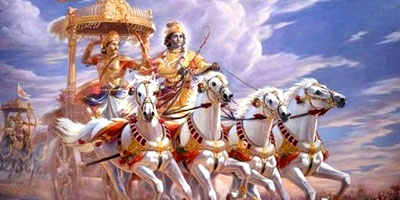THE BHAGAVAD GITA
by Pamela Joy Swift
The
Bhagavad Gita is an epic poem that was verbally passed down from Bhraman
to Bhraman about 6,000 years ago. It was finally written down about 2,500
years ago, and inserted as Book 6 of India’s national epic, the Mahabharata.
The Mahabharata is a very long poem that tells the story of a war between
two clans of a royal family in northern India. One clan, the Pandavas,
is led by Arjuna and his four brothers. The other clan is the Kauravas,
made up of the hundred sons of the blind King Dhritarashtra, who are the
evil cousins of the Pandavas.
Most
of the story takes place on a battlefield in Kuru, India. At the beginning
of this monumental battle, Arjuna has his charioteer, Krishna, drive him
into the open space between the two armies so he can survey the troops.
As Arjuna looks around he sees his brothers, cousins, and many other fellow
kinsmen. He becomes so overwhelmed with sorrow and angst at the certain
death of so many brave warriors, that he drops his bow and arrow, sinks
to the floor of his chariot, and refuses to fight.

It
is at this point that Krishna begins to teach Arjuna about the true purpose
of life, about nonattachment, about the illusion of death, the importance
of duty, and the realms of the true Self . Most of this famous poem is
a spiritual teaching delivered through a monologue spoken by Krishna, with
Arjuna asking, again and again, for more explanation.
Though
Krishna and Arjuna’s dialogue seems to last for hours, the entire story
actually takes place in a single moment. In the middle of a battle field,
in a single moment, time as we conceive of it, stops. In this moment of
apparent urgency: in the middle of two, huge armies, each prepared to engage
in fierce battle, Krishna begins this long discourse explaining to Arjuna,
why he must get up and fight. Whether Arjuna should fight or not, is a
metaphorical question, for the actual question being addressed in this
poem is not “Is it okay to kill?”, but rather, “How should we live?” It
seems awkward for this long discourse to occur right in the middle of a
battle field, however, the symbolism this timing illustrates is also critically
important to the theme of Krishna’s message: There is no other time than
right now, nothing in this illussioned world is real, and our dharma, our
purpose in this lifetime, is our spiritual duty, and therefore must be
carried out without hesitation. Arjuna was the commander of a huge army.
His dharma, his spiritual duty on Earth, was to successfully lead his soldiers
into a victorious battle against King Dhritarashtra and his evil sons.
The
Bhagavad Gita was originally written in Sanskrit, the ancient language
of India. The title translates into English as “A love song to God”. It
is an instruction manual for spiritual practice, and a guide for those
who yearn to experience peace in the heart. The purpose of the Bhagavad
Gita is to lead us to a deeper understanding of our “yoga” practice. Yoga
is not just about learning the hatha yoga postures and the breathing techniques.
The practice of yoga is about experiencing our union with the divine. When
we understand this simple truth we easily recognize our purpose in life,
and we live and act from the same spiritual awareness that Krishna taught
Arjuna. We let go of our desires for particular results in this world,
and we live from a place of surrender and devotion to the present moment.
We do this on the yoga mat, and we do this off the yoga mat as we are walking
through the world.
I
encourage you to ponder the following excerpts
from
Stephen Mitchell’s translation of The Bhagavad Gita:
These
bodies come to an end;
but
that vast embodied Self
is
ageless, fathomless, eternal.
Therefore
you must fight, Arjuna.
Know
what your duty is
and
do it without hesitation.
For
a warrior, there is nothing better
than
a battle that duty enjoins.
If
you are killed, you gain heaven;
triumph,
and you gain the earth.
Therefore
stand up, Arjuna;
steady
your mind to fight.
Self-possessed,
resolute, act
without
any thought of results,
open
to success or failure,
This
equanimity is yoga.

